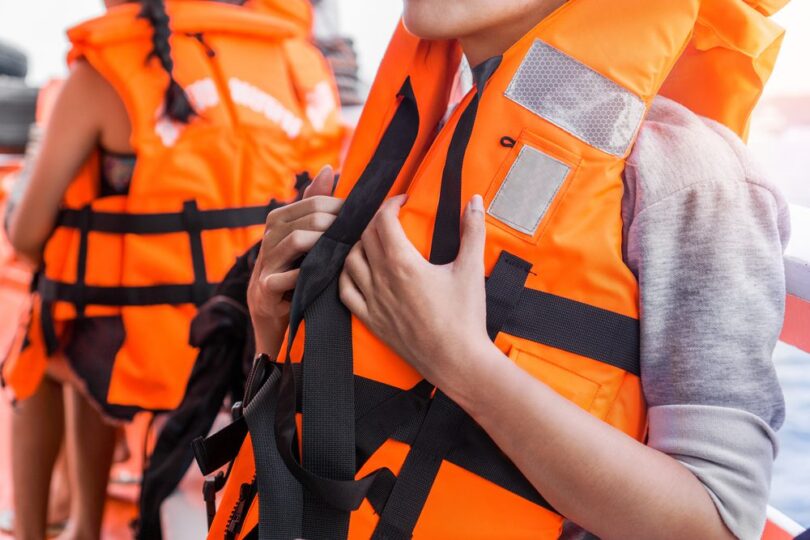Whether you’re boating, kayaking, swimming, or participating in any water activity, understanding the basics of life jackets or personal flotation devices (PFDs) is essential for your safety. In a dangerous situation or unexpected circumstances, PFDs are crucial equipment designed to keep individuals afloat and increase their chances of survival in water.Â
On the other hand, PFDs provide buoyancy to people who struggle to keep themselves afloat or their heads above the water. For this reason, it’s necessary to familiarise yourself with the different kinds of PFDs before trying out recreational activities that involve being close to a body of water.
Table of Contents
Types of PFDs
PFDS come in different shapes and sizes that are tailored-fit to your comfort and the type of activity you are engaging in. While most life jackets are wearable, like the standard orange life vest that people usually wear, some PFDs are throwable and cannot be worn.
Offshore Life Jackets
Offshore PFDs are wearable life jackets that are designed to provide the highest level of buoyancy. This type of PFD should be buoyant enough to flip an unconscious person face-up from being face-down into the water to avoid drowning.Â
The likelihood that the unconscious person would live is significantly increased by this life jacket style, which has the most buoyancy. They are suitable for open, rough, or remote waters where rescue may take longer.
Perfect for:
- Racing
- Offshore fishing
- Cruising
- Boating alone
- Boating in bad weather
Near-Shore Buoyant Vests
Near-Shore Buoyant life jackets are designed similarly to Offshore PFDs; both can be worn and turn a person upright in the water. If they are having trouble staying afloat, Near-Shore Buoyant PFDs will assist them in maintaining their head and face above the water so they can breathe.
The difference is that Near-Shore Buoyant PFDs are suitable for calmer waters and provide a slightly lower buoyancy level than Offshore life jackets.
Perfect for:Â
- Sailing
- Fishing
- Cruising close to the shore
Flotation AidsÂ
Unlike Offshore and Near-Shore Buoyant life jackets, Flotation Aids are only designed to support conscious people, keep them floating, and offer a good balance between comfort and buoyancy.
Perfect for:Â
- Kayaking
- Canoeing
- Jet skiing
- Other water sportsÂ
Throwable Devices
Throwable Devices come in various buoyant cushions, such as a square, ring, or horseshoe. In that case, Throwable devices are not worn but are meant to be thrown at someone in distress to keep them from drowning.Â
The law requires that most recreational boats always have one throwable PFD on board. To be easily accessible when needed, it must also be within arm’s reach.Â
Special-Use Devices
Regarding regular recreational sailing, Special-Use Devices are the least popular because they are designed for certain activities and have specific instructions. These should only be used if an immediate rescue is possible because they cannot turn an unconscious person around. Â
Perfect for:
- Boardsailing
- Commercial white water rafting
- Depends on the device’s label
Choosing the Right PFD
Always ensure that the pfd life jacket fits snugly and comfortably by trying it on. Choosing the right PFD means it should provide enough buoyancy suitable for your intended water activity. You should also check the manufacturer’s size recommendation, weight range, and buoyancy rating.
While keeping your head above the water is important, you should consider comfort and mobility. Look for PFDs that allow freedom of movement and don’t restrict your ability to swim or perform water activities.
Proper Wear and Maintenance
If you are a non-swimmer, wearing a PFD when engaging in water activities will always be necessary. You can always adjust all the straps and buckles for a secure fit so the PFD won’t slip off while using it.
You should also regularly inspect your PFD for any signs of damage or wear and tear. It should be immediately replaced if it is damaged or no longer functions properly. Cleaning your PFD according to the manufacturer’s instructions is also important.Â
However, there are harsh chemicals or solvents that you should avoid because they could damage the materials. PFDs should be stored in a cool, dry place away from direct sunlight.
PFDs for Your Safety
Remember, wearing a life jacket can guarantee your safety and significantly increase your chances of survival in an emergency. However, there are other things you should consider to stay safe while engaging in water activities, such as:Â
- Educate yourself about local water conditions, such as currents, tides, and weather forecasts.
- Always follow boating regulations and guidelines specific to your area.
- Never consume alcohol or drugs while participating in water activities, as they impair judgment and reaction time.
You should also learn basic swimming skills and water safety techniques. Choosing the right PFD for your activity is essential, ensuring it fits properly and maintaining its good condition. Stay safe, and enjoy your time in and around the water!
Reference:
https://www.boatsmartexam.com/knowledge-base/article/life-jackets-pfds/Â
https://www.cabinlife.com/articles/what-you-need-to-know-about-pfdsÂ
https://www.takemefishing.org/boating/boating-and-water-safety/what-is-a-pfd/Â
https://seabrookmarina.com/blogs/news/life-jackets-101Â
https://www.lakehomes.com/info/lifestyles/staying-afloat-life-jacket-classifications-101Â

This is really interesting, You’re a very skilled blogger. I’ve joined your feed and look forward to seeking more of your magnificent post. Also, I’ve shared your site in my social networks!